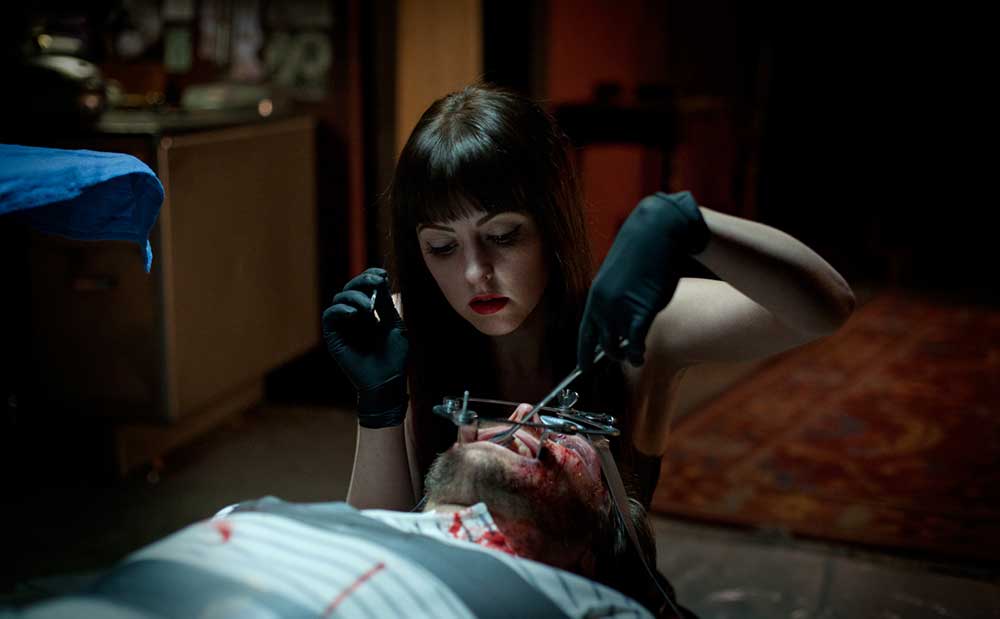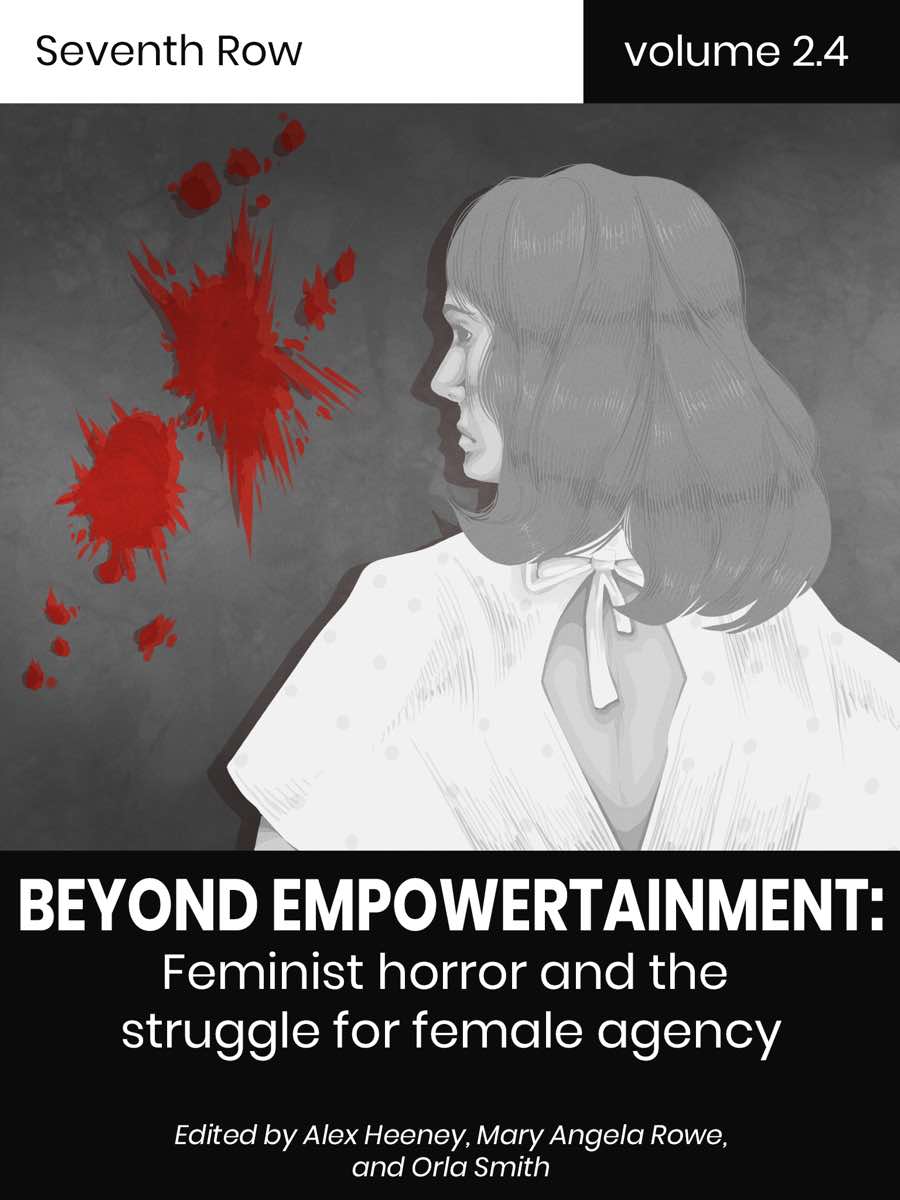Rosie McCaffrey discusses why Katharine Isabelle’s performance in American Mary is one of her favourites by an actress in a horror film. Explore our coverage of Women in Horror Month here. Discover our book about feminist horror here.

The Soska sisters wrote American Mary, their 2012 body horror revenge movie, with Katharine Isabelle in mind. It’s perfect casting, subverting the expectations set up by her cult-favourite turn as the demented and bloodthirsty Ginger in Ginger Snaps (2000); in American Mary, Isabelle navigates her character’s struggles with cool, aloof restraint.
In American Mary, Isabelle tracks the thrilling revenge arc of a woman, Mary Mason, coming undone as she rises up against her assaulter. Mary Mason is a promising but financially insecure med student who reluctantly begins moonlighting as a back-alley surgeon. Seen as too soft by her instructors, she feigns emotional detachment and ruthlessness in order to impress them. Her ambitions are shattered, however, when her professor invites her to a party where he drugs and rapes her. Traumatised and humiliated, she drops out of school, adopts the impersonal ruthlessness so hallowed by the surgeons, and exacts revenge by using her professor as practice for her new career in body modification. Soon, her reputation precedes her, but her pursuit of vengeance erodes all vulnerability until she and her icy exterior are indivisible.
At the start of the film, Mary is eager to show her instructors she has what it takes to be an excellent surgeon In order to succeed in the sociopathic, male-dominated world of med school, she must appear to act without empathy. While appearing cold-hearted on the surface, Isabelle reveals flashes of the feelings that Mary is keeping in check. Small moments of hesitation and awkwardness reveal how Mary feels required to compromise herself. When she is instructed to break the news to a family that their father is dead, having just told them he was alive, Isabelle communicates Mary’s unease in a split-second startled expression before she composes herself and does as she’s told. When the surgeons make distasteful jokes about getting to cut up bodies for a living, Isabelle’s ingratiating, nervous laugh is a sign of Mary’s discomfort as she tries desperately to fit in.
We see the real, empathetic Mary when she performs a clandestine surgery away from the leering eyes and condescension of the surgeons at school: the patient’s pain touches Mary and breaks down her unemotional exterior, so Isabelle touches him gently and carefully. “Shhh, it’s going to be okay,” Mary murmurs softly so only he can hear. At home, she cries in the shower, deeply affected by the incident.

After Mary’s assault, she is merciless and vengeful, no longer willing to compromise for the men around her — but tragically, the trauma of the event brings her closer to the sociopathic monster they wanted her to be in the first place. In a wide shot reminiscent of a blood-soaked Carrie White exiting the burning gym hall, Mary enters her apartment and sidles over to her coffee table, upending it in anger. The walk Isabelle chooses is peculiar: in high heels, her hips swing alluringly, but her gait is also jolty and disjointed, like a marionette doll with tangled strings. It could be the walk of someone in shock, but it could also be the walk of a predator. The next day, when she abducts her rapist, Dr. Grant, to begin her bloody revenge, she’s remarkably calm. Her eyes are deadened and she never seems present in the moment. Her voice is soft and singsong, lilting between playful and deadpan. Her movements are slow and languid, even as she tells Dr. Grant, in gruesome detail, all the things she’s about to do to him.
Mary’s revenge is not frenzied but calculated; she calmly and methodically uses Dr. Grant for surgical practice, her impersonal treatment of his body an icy match for his savage violation of hers. Isabelle plays out the aftermath of Mary’s trauma as though she’s in shock, can’t engage directly with her turmoil, and wants to protect herself from further damage. It’s no longer a performance for anyone else, but one to keep herself safe and guarded.
Having struggled against the hindrance of her own natural empathy in the clinical setting of med school, Mary is now only able to connect with her emotions through feelings of anger and violence. When a cop discovers the mutilated body of Dr. Grant, she beats him to death. Here is yet another man invading her space, this time the space where she was privately coming to terms with her trauma. Her movements are powerful and propulsive as she repeatedly brings the weapon down on the cop long after he’s dead. Because Isabelle keeps Mary so sedate, considered, and detached through most of her post-assault scenes, when Mary gives into violence, it feels hugely cathartic, as if all the feelings that have been suppressed are now exploding in a bout of ferocious energy.
Mary achieves the clinical detachment the surgeons encouraged, but it cost her something soft and human. In the penultimate scene, she asks strip-club owner Billy (who has a misguided romantic interest in her), “Do you think I’m crazy?”. Her face barely shifts from its default composure and detachment, but the effect of this minute change is huge. Eyebrows slightly knit and eyes unfocused, for a moment, she seems connected to what is inside her, and she’s troubled by it. When Billy invites her on a getaway trip to LA, her eyes roll around the bar, looking anywhere but at him. Initially, she seems sassy and disinterested, but the wet gleam in Isabelle’s eyes suggests the painful realisation that she can’t change; she’s gone too far to accept the intimacy he’s offering. Getting up to leave, she looks at Billy fondly, but the ice is back when she sing-songs, “I’ll think about it”.
Explore our coverage of Women in Horror Month >>


